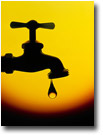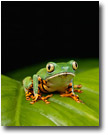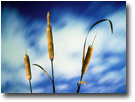 |
 |
||||
Note - Thumbnails are links to full size images. Got the winter photo blahs? Are you feeling a little uninspired by the frozen world around you? Well, why not shoot some great nature photos in the comfort of your home? “I can’t afford fancy lighting gear, and I don’t have room for a studio”, you think. Well, fear not, here I will show you how you can make great indoor nature shots using lighting gear you probably already own. And best of all you’ll be comfy and warm and only seconds away from the refrigerator! Photo 1 shows the lighting gear I commonly use in my photo ‘studio’ (most often the kitchen table). Not shown is my most important lighting tool (the kitchen or living room window). I also use reading lamps, flashlights, light-tables for slide viewing, slide projectors, and small flash soft-boxes in my studio work. Let’s explore some images made with these light sources. Window Light Windows are wonderful sources of light for indoor nature photography. Where the other light sources mentioned often produce results that look ‘artificial’, window light is totally natural looking. Most often I use the light streaming in from the window to backlight or sidelight my subject. To help reduce contrast I will reflect light into the shadow side of my subject using a piece of crumpled aluminum foil or a small hand mirror. In Photo 2, strong directional window light adds mood to the flowers. The background is our white kitchen wall that has turned dark because it is in the shadows. Because wind is not a problem indoors, you are free to experiment with any combination of aperture and shutter speed to help convey a look appropriate to the subject. Reading Lamp A lamp with a flexible neck is a useful tool for indoor nature photography because the light can be adjusted easily to various angles. In Photo 3 I used the lamp at an extremely low angle to strongly side-light the veins on this leaf. The result is graphic and dramatic. In Photo 4 I used a lamp from below to under-light the details of frost patterns on my kitchen window. I converted the image to black and white to increase the stark effect of this lighting. When shooting with tungsten light sources like a reading lamp (flashlight, slide projector or light-table) you might want to use an 80B (blue) filter over the lens if you want accurate colours (or if using digital camera change the white balance to tungsten). Personally, I love the super warm colours that you get when shooting daylight film under tungsten light, so I rarely filter my studio shots. Light-Box An overlooked but excellent light source is a light-box. Many photographers who shoot slide film will have a light-box or light-table for viewing slides. These make wonderful sources of light for two purposes. First you can lay objects on the light-box and if they are translucent light will pass through the object making textural images possible (see Photo 5 of an aspen leaf and textured art paper taken using a light-box as the sole light source). Second, you can use a light-box as a large diffuse source of light like you would with a soft-box on studio lights. My light-box is 8 ˝ by 11 inches and provides very natural looking light (Photo 6). The light-box is not bright so you will need longer exposures (e.g. 1 to 30 seconds), so a tripod is mandatory. Slide Projector One of my favorite studio lights is a slide projector. With it I have a bright source of focusable light that is especially good for spotlighting or backlighting objects. In Photo 7 I used the light from a projector to create a silhouette of a beetle (a mounted museum specimen) on a leaf. I also use a slide projector to create interesting backdrops for my studio shots. In Photo 8 I projected a slide of a sunset onto a white wall and then photographed a tap and glass water drop in silhouette against the projected backdrop. Soft-Box With active animals the light sources mentioned above are usually not bright enough for action stopping photos or require long exposures. A camera flash provides bright controlled lighting with short exposure time. The drawback to on-camera flash is that it provides harsh frontal light – not very attractive for nature shots. The solution for better lighting is to get your flash off-camera using a flash sinc cord, and then softening the light by using a soft-box over the flash. Many manufacturers make small portable soft-boxes for camera flash that range from $30 to $150. My favorite one is the Fotoflex Litedome Q39. It is big enough to provide wonderfully soft looking light when shooting small animals like frogs and butterflies. In Photo 9 I used two off-camera flashes and two soft-boxes to light up our pet frog Leroy on a house plant. Flashlights Another versatile lighting instrument is the flashlight. I often use one to spotlight subjects or to do light-painting. I’ll usually combine two or more sources of light when I photograph with a flashlight. Often I use ambient room light and a flashlight together or maybe project a slide on the wall for the background and light the foreground subject with a flashlight (see Photo 10). In an upcoming article I will explain details of how to paint light into your scene using a flashlight. Anything that emits light can be used for creating nature photos indoor. Look around your house for sources of light and experiment with how the light makes your nature subjects appear. Don’t let the winter blues prevent you from making new nature images. Great shots are as close as your nearest lamp! DW-NPN 0343 About the author... Darwin Wiggett and his wife Anita Dammer are the proprietors of Natural Moments Photography. Anita has 17 years experience as staff photographer for the Glenbow Museum in Calgary and is currently the editor-in-chief of Photo Life magazine. Darwin has been shooting stock since 1990, and has two books published by Whitecap in Vancouver; Darwin Wiggett Photographs Canada and Seasons in the Rockies. Darwin's newest book, How to Photograph the Canadian Rockies will hit the shelves in the spring of 2005. Together they specialize in landscape, nature, animal, humor and kid photography and are represented by various stock agencies worldwide. Their primary stock agent is First Light in Toronto, Canada. You can view more of Darwin's work at www.darwinwiggett.com and on his online portfolio. Comments on NPN nature and wildlife photo marketing articles? Send them to the editor. | |||||
|
|
|||||









